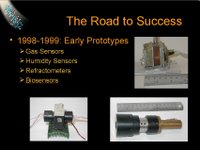FarField Scientific's novel Differential Interferometric Bio / Chemical Affinity Instrument

Farfield Scientific is a small innovative firm, that has taken what would be more commonly implemented in an exotic Mach Zehnder fiber coupled interferometer and changed this into Dual [slab waveguide] Path Interferometer, rendering the experimental sensing configuration easier to use, broadly adaptable and seemingly vastly more sensitive in practice.
Farfield Scientific is a spinoff of the University of Durham's Department of Physics of work orginally done by Prof. Graham Cross.

Farfield Scientific makes a surface sensitive instrument that is readily applied to otherwise difficult to quantify Chemical Affinity testing - configured with a convenient and sensitive optical path for quantifying surface reaction and chemical binding properties.

Where typically it is almost conventional to use a single mode optical fiber coupled Mach Zehnder interferometer for this kind of affinity / binding measurments (or AFM force curves, or exotic surface force apparatus), the logistics of conventional MZ sensing are needlessly bothersome and the information from MZ sensing actually limited in dynamic range and data interpretation due to a single intensity output for the optical path interference sensor. MZ single mode waveguides suffer from limited sample size, and more tedious sample preparation, as is the case of data taking with the AFM and surface force apparatus. This among several limits to other chemical affinity measurement methods.
 Farfield's scientists Prof. Graham Cross of Durham University and the company team have implemented a novel and simplifying optical configuration to enable practical application of large dynamic range interferometry methods to chemical reaction / binding quantification- with interferometry's inherent amazing sensitivity, but in a very practical optical path with the benefit of imaging projected farfield interference patterns rather than a single intensity signal from an otherwise typical MZ interferometer.
Farfield's scientists Prof. Graham Cross of Durham University and the company team have implemented a novel and simplifying optical configuration to enable practical application of large dynamic range interferometry methods to chemical reaction / binding quantification- with interferometry's inherent amazing sensitivity, but in a very practical optical path with the benefit of imaging projected farfield interference patterns rather than a single intensity signal from an otherwise typical MZ interferometer.This last seemingly trivial point, of measuring from projected interference patterns is actually critical to more widespread application of interferometric sensing of chemical affinity, and is where otherwise conventional Mach Zehnder configurations are prone to errors in signal generation / interpretation - or at least suffer from limited dynamic range.
Here is a list of links to titles of some of the firm's earlier applications notes
Polymer Surface Interaction
Quantitation of Surface nanostructures by DPI
Real Time observation of Actin Polymerization
Early Stage B-Amyloid Aggregation by DPI
Calcium Ion Binding effects on Transglutamase
Real Time Lipid Bilayer observation
Physisorbtion and effects of Surfactant
Real Time Studies of Protein Lipid Interactions
Contact Lens Biocompatibility
Structural Change in Antitrypsin on Small Molecule Binding
Changes in MAP Kinase for Small Molecule Binding
Biotin Streptavidin interactions
Molecular basis for an Inhibitor of B-Amyloid Aggregation
Beta Amyloid Aggregation under Different Surface Conditions
High Resolution Real Time studies of C12E4 Surfactant
Small Molecule Partitioning into C18 membrane Mimics
Affinity Studies of Glycoprotien Lectin interactions
Synnuclein Agreggation
Effect of Melittin on Phosphatidylcholine Liposome Interactions
Properties and Aging Behaviour on Thin Spun PVC
It is clear that the firm is tending towards biochemical applications of the technique and this is good and attests to the power of the basic method as to the ease of experimental data capture and sample preparation, and the sensitivity of the measurement.
 The basic optical path technique has been previously applied to novel sensor heads for pressure and humidity sensing among other applications, but the real home for the astounding innovation is in studying biochemistry.
The basic optical path technique has been previously applied to novel sensor heads for pressure and humidity sensing among other applications, but the real home for the astounding innovation is in studying biochemistry.Here is a link to patents [US, US apps, and EU] that are mostly from Prof. Graham Cross (plus a few unrelated stragglers of no connection). Most in the list are relevant to the sensor technology with a few fairly obvious exceptions..
I will profess to hardly hearing of this method until I observed folks from the firm visiting my blog. I was hugely intrigued by what I learned at the Durham and Farfield web sites. The business strategy of focusing the application of the innovation on scientific markets with a full up instrument and support with a nice array of application notes reminds me of the early days of growth of Digital Instruments, albeit the market has slightly less dynamism / imperative than the heady early days of AFM.
Congratulations to Prof. Grahama Cross and the Farfield Scientific team are deserved for the superb and novel innovation commercialized. The instrument is conceptually simple, the device technology is superbly elegant and enormously powerful.
I'd love to see some biochemical / medical challenge elucidated quickly by Farfield's Dual Path Interferometer, aside from seeing the firm grow to the sucess that it seemingly deserves. More chemists, biologists and their relatives should learn about the power of Farfield's instrument technology.
Wendman nanotechnology nanotech microfluidics biotech chemical+affinity AFM+Force+Curve Interferometer MZ+Interferometer Mach+Zehnder+Interferometer Bioaffinity Chemical+Sensor SMR Biosensor Biomedical



0 Comments:
Post a Comment
<< Home